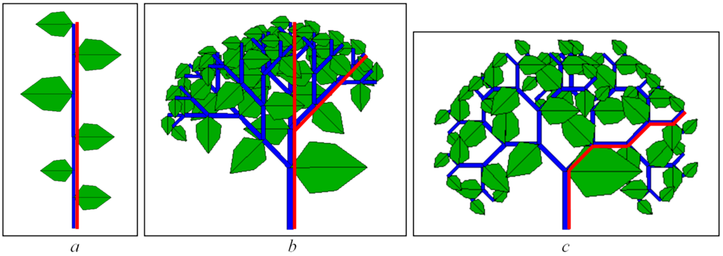GreenLab Course
Development
Factorisation
Organic series
-
The evolutions of cohorts are called organic series, a term coined by R. Buis in 1983.
Ageing
-
The ageing evolution of a given cohort Co(p,da,dc+n),
is simply the chronological evolution; the current date is incremented (by a number n of growing cycles).
In such a case, usually:
-
- the number of elements in the cohort is assumed to be constant
- the corresponding organ sizes (corresponding to the biomass allocated so far) increase
- the corresponding organ gets older, and may reach its term of functioning.
Position along an axis
-
Evolution can also be considered on the basis of structural elements.
We will show further, that field observations carried out on series built from organs on the same axis, from tip to insertion, allow structural statistical properties to be expressed.
In this case, the series is built from representatives of cohorts on successive appearance dates, corresponding to successive ranks of organ insertion along the axis.
In fact, along the axis, the organic series can be considered from the list of cohorts related to the appearance dates dai -> daf (= dc) of the organs.
From top to bottom, each organ position defines the rank in the cohort set.
These ranks will be consecutive if organ appearance was effective for each growth cycle (no rests).

Organ Series in plant structures (Drawings P. de Reffye, CIRAD)
- These examples of series are shown in red, on three structures of the same unique physiological age and same chronological age.
a) A single axis with different phytomers. Two organic series respectively related to the leaves and the internodes describe the organ successions from upper tip to bottom.
b) A monopodial structure showing two similar organic series paths. From apex to seed, all organic series are identical; the successive organ ranks are related to the same cohorts.
c) A sympodial structure. Here also, from apex to seed, all organic series are identical. On this example, they are also identical to those of the monopodial structure, since cohorts from both monopodial and sympodial structures share the same number of organs and organ sizes.
GreenLab development equations
-
Retrieving the number of organs
-
Let No(n) be the number of organs o functional at cycle n.
This number is to be defined by summing up the organs within the plant structure.
We can thus write:
No(n) = Σp = 1 ; pmax Σk = n - to + 1 ; n No(p,k)
where
-
p is a physiological age
pmax the older physiological age.
No(p,k) is the number of organs o in all cohorts of physiological age p, born at cycle k (k <= n)
to is the functional period of organ o
No(p,k) can be retrieved when organogenesis is performed by the double scale automaton, using a simple counting programme.
It is possible to formalize recursively the computation of No(k) using the sub-structure constructions.
Bibliography
Buis, R., Barthou, H. 1983. Relations Dimensionnelles dans une série organique en croissance chez une plante supérieure. IXème Congrès international de Biologie Mathématique, Paris, 8-10 septembre 1983. Bio-Mathematics revue, Les éditions européennes - France., pp. 1-19 (pdf)
